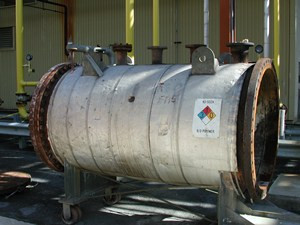At a plastic manufacturing facility, an explosion fatally injured 2 operators and one maintenance technician around 2:40 am as they were performing a maintenance operation on a polymer catch tank. The force created by the ejection of gas and plastic propelled the tank backward and bent the attached piping. A section of hot oil supply tubing (370 °C) for a heating jacket on the inlet line from the reactor knockout pot to the catch tank broke, and the fluid spilled into the area. A flammable vapour cloud formed and ignited within a few minutes. Despite the immediate start of the area water deluge system, 6 hours of firefighting were required to extinguish the fire. The catch tank was designed to receive partially reacted plastic waste diverted from the chemical reactor during periods of start-up and shutdown. Twelve hours prior to the incident, an attempt was made to start the production unit, but the start-up was aborted after 1 h due to problems with the extruder downstream of the reactor. As part of the procedure, the catch tank had to be cleaned of material (hardened plastic) and 3 employees therefore attempted to remove a cover. After half of the 44 bolts had been removed, pressure inside the vessel caused the remaining bolts to break and the cover to fly off. The workers were struck by the cover and the expelled plastic. The US CSB investigated the case and found that an unusually large amount of partially reacted material had been sent to the polymer catch tank during the startup phase, where it continued to react and began to slowly decompose, thereby generating gases and causing the contents to foam. The material expanded as foaming continued, and eventually the entire tank was filled. The material then forced its way into connecting pipes, including the normal and emergency vents. The plastic solidified as it cooled ; however, the core of the plastic mass remained hot and molten, and likely continued to decompose over several hours, generating gases that pressurized the vessel. The personnel could not know the vessel was pressurized as the pressure gauge on the (blocked) vent piping was unreliable and the equipment opening procedures did not specify what actions to take when safety precautions could not be met, explaining why the workers unbolted the vessel as usual. The CSB underlined several organisational errors : – the operator did not adequately review the conceptual process design to identify chemical reaction hazards. In particular, reactivity hazards, such as unintended reactions, were not examined in the final design-phase hazard analysis (from pilot plant to normal scale). – despite several incidents, near-misses and technical problems in the process over the years, management did not ensure that deficiencies were properly analysed and corrected. – design documentation did not adequately describe the process, resulting in misunderstandings (no specified max level, no warnings about overfilling risks ) and was not up-to-date. – no management of change review had been carried out to evaluate the effects on safety of a change in the start-up procedure that increased the amount of waste to be disposed of to the vessel.




